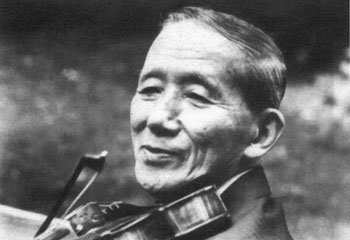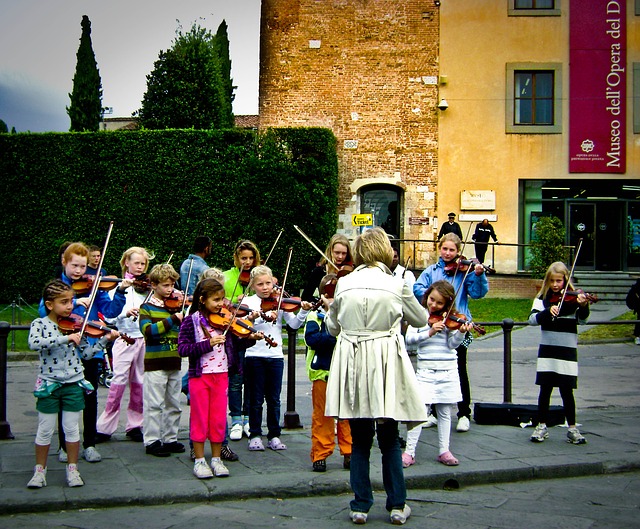Why Suzuki?

The Suzuki Violin method is a group of books containing songs/pieces of educational significance.
As with any method, it starts out very simple and works it’s way up from there.
I personally have found a great deal of merit in using this method under the right conditions.
However, I will start out by advising prospective learners and buyers that the Suzuki method was written not as a “teach yourself violin” method book.
Looking To Teach Yourself Violin? Try Out The Essential Elements Method and Our Review
You’re going to have some difficulty learning how to play the instrument if today is the first day you picked up the violin.
This method was constructed with having a Suzuki instructor in mind.
For this reason, I recommend you have a Suzuki teacher that is ready to help you learn.
On the positive side (and there are some incredible positives), any child can learn as soon as they exhibit interest in music, and their parent is willing to be intricately involved in their practicing.
A child can literally start learning the Suzuki method at the age of 3. This gives the student an INCREDIBLE head start.
Additionally, this method includes a wealth of wonderful pieces specifically for the violin and in so doing, gradually teaches the student how to improve without the student necessarily realizing it.
So now that we know the two main pros for learning via the Suzuki method, let’s analyze them further!
Learning at an early age

Unlike other methods, the Suzuki method does not require you to immediately read sheet music. Therefore, you do not have to even know how to read your native language in order to play the violin. This both excites and infuriates people, depending on who you’re talking to.
I personally think it’s a great boon to the student. I have taught many a student who could not read english.
However, they could play the violin, often beautifully.
We accomplish this in two ways: the student mimics what they see the teacher perform, and the student listens to the accompanying CDs that come with purchasing the Suzuki method.
These audio tracks are the basis for the learning structure of all things Suzuki.
The teacher can not be present all week long, but the student can certainly listen to a CD all week long.
In so doing, the student learns the sounds they are supposed to produce and become aware of the rhythms and timing they are to perform as well.
When these two methods (imitation via sight and imitation via sound) are executed properly by the instructor and practiced adequately by the student, you have what I have cultivated in many of my youngest students: a child that can play the violin before they can read.
Why is this important? Because the head start they receive allows them to conceivably have played their instrument for 10 years by the time they reach the age of 13, 14, 15, or 16.
By then, the level and speed of learning has compounded and they are well on their way to becoming incredible performers and musicians.
A wealth of inherently educational material

The songs listed in the Suzuki method are in a specific order for a specific reason.
In book one, they teach students the basics of rhythm, pitch making, and performance.
With the progression of the Suzuki method, one can learn things as simple as where to place the fingers and how to use the bow as well as more complicated techniques such as colle, spiccato, trills, and shifting (over the course of several books).
The order in which the songs are presented are well thought out and allow for a very natural increase in the knowledge and skill of the player.
Additionally, the songs in the books are regarded as beautiful pieces by all of my students as well as musicians in general.
Unlike other methods, you’ll learn pieces that will continue to tickle your sonic taste buds.
Many of the songs in other methods sound far too much like etudes and exercises.
While I personally have a fond place in my heart for such skill builders, I find that most students prefer to play pieces that are aesthetically pleasing.
In other words, pieces with melodies. This is where the Suzuki method shines.
Final thoughts

In conclusion, each method has pros and cons.
I recommend the Suzuki method to anyone who has a young child who hasn’t or is just learning to read and write their native language.
Also, I recommend starting children on the violin as soon as they can keep their focus for five minutes.
For these reasons I teach and recommend the Suzuki method.
If you’d like to purchase books 1, 2, or 3, you can find links below. I’ve included links to the books that include CDs.
They will help you in your learning, but you don’t absolutely need the CD if you’re using our YouTube page to play along.
Suzuki Violin Volume 1 with CD
- Suzuki, Shinichi;Hahn, Hilary;Zhu, Natalie (Author)
- English (Publication Language)
- 48 Pages – 07/01/2020 (Publication Date) – Alfred Music (Publisher)
Suzuki Violin Volume 2 with CD
- Suzuki, Shinichi;Hahn, Hilary;Zhu, Natalie (Author)
- English (Publication Language)
- 36 Pages – 07/01/2020 (Publication Date) – Alfred Music (Publisher)
Suzuki Violin Volume 3 with CD
- Suzuki, Shinichi;Hahn, Hilary;Zhu, Natalie (Author)
- English (Publication Language)
- 28 Pages – 07/01/2020 (Publication Date) – Alfred Music (Publisher)



